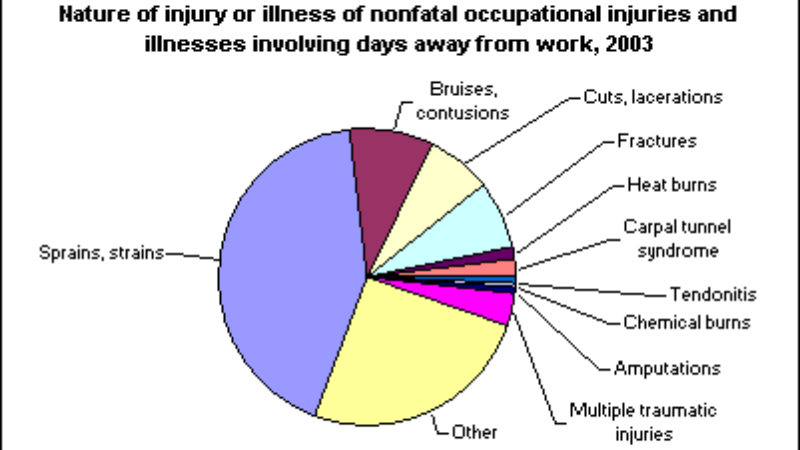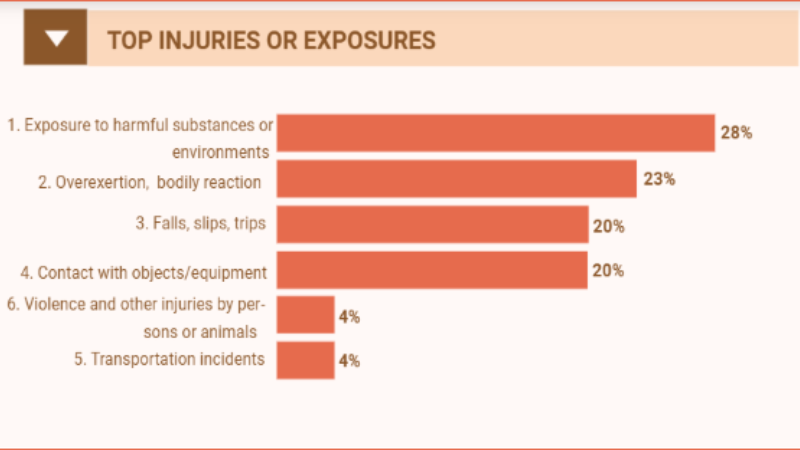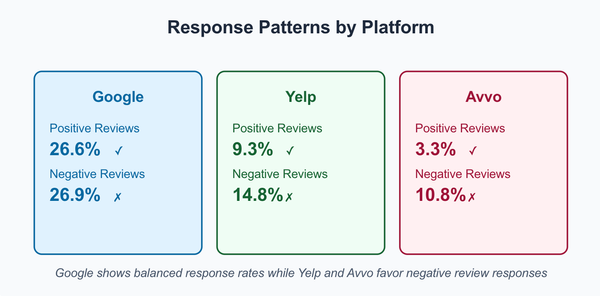Key Statistics on Workplace Injury Claims and Legal Actions in 2024

Workplace injuries continue to be a global concern influencing employee well-being and business operations. According to the U.S. Bureau of Labor Statistics, private industry employers have reported 2.6 million nonfatal workplace injuries and illnesses in 2023. These injuries highlight the long-term consequences and risks for workers across various industrial sectors.
Let's take a closer look at the key statistics on workplace injuries and the legal actions to seek justice and compensation.
Key Workplace Injury Statistics in 2024
In 2023, a total of 5,283 fatal and 2,569,000 non-fatal work-related injuries were reported across various sectors, including construction, transportation, and manufacturing. The healthcare and social assistance sector saw a significant increase in injuries, rising from 27,800 cases to a total of 471,600 in 2023.

- Accommodation and food services, arts, entertainment, recreation, and utilities have experienced an increase in injuries.
- The manufacturing sector has reported a decrease of 21,400 injuries.
- The wholesale trade sector saw a reduction of 11,900 injuries, down to 127,000 workplace injury cases in 2023.
These statistics highlight the need for robust safety standards, proactive injury prevention, and the legal implications of failing to ensure a safe working environment.
Understanding Workplace Injuries Types Statics in the USA by Numbers
Soft tissue injuries, including damage to ligaments, tendons, and muscles, were the most common type of injury claim in 2023. These injuries often happen when the body is stretched, twisted, or overworked. The other common injuries result from:

- Sprains and strains account for 42.9% of all workplace injuries. About 1 million cases of sprains and strains were reported in the U.S. workforce in 2023.
- Bruises and contusions make up 9.0% of all workplace injuries. Around 600,000 workers reported bruises and contusions in 2023.
- Cuts and lacerations account for 7.3% of workplace injuries. Approximately 700,000 workers reported cuts and lacerations in 2023.
- Fractures from falls or accidents make up 7.2% of all workplace injuries. Over 200,000 U.S. workers in 2023 experienced fractures.
- Carpal Tunnel Syndrome caused by repetitive wrist movements, accounts for 1.7% of workplace injuries. Around 150,000 workplace injury cases of carpal tunnel syndrome were reported in 2023.
- Heat burns from exposure to hot surfaces or liquids contribute to 1.5% of workplace injuries. Around 30,000 heat burns were reported in 2023.
- Tendonitis represents 0.6% of workplace injuries. Over 100,000 workers in the U.S. reported tendonitis injuries in 2023.
- Chemical Burns make up 0.6% of workplace injuries. Approximately 25,000 chemical burns were reported by U.S. workers in 2023.
- Amputations account for 0.6% of injuries. There were about 2,500 amputation workplace injury cases in 2023.
Leading Causes of Workplace Fatalities in 2024
Workplace injuries affect many employees each year. This results in lost work time, medical expenses, and long-term health problems in employees. The leading causes of workplace fatalities are:

- Exposure to Harmful Substances: About 28% of Injuries happen when workers come into contact with dangerous chemicals or toxic materials at the workplace.
- Overexertion and Bodily Reactions: Approximately 23% of workers lifting heavy objects, pushing, pulling, or doing the same task over and over have muscle strains or sprains.
- Falls, Slips, and Trips: Workers who slip on wet floors, trip over objects, or fall from heights account for 20% of serious injuries.
- Contact with Objects or Equipment: 20% of injuries happen when workers are hit by moving objects, caught in machines, or are hurt by tools or equipment.
- Transportation Incidents: 4% of vehicle or equipment accidents while transporting products cause workplace injuries.
- Workplace Violence: Violence at work, including assaults or injuries caused by animals or other people, makes up around 4% of workplace fatalities.
What Laws Protect Workers From Workplace Injuries?
US workplace injury laws and regulations protect workers' rights in the event of an injury at the workplace. The laws ensure that workers get medical care, financial compensation, and safe working conditions at the workplace. The key laws protecting the workers at the workplace in the event of injuries are:
Occupational Safety and Health Administration Act
The OSH Act regulates and ensures workplace safety standards across industries. The workers under this act are entitled to:
- Receive safety and health training in a language they understand.
- Work with machinery and equipment that meet safety standards.
- Refuse to work in conditions that expose them to hazardous situations.
- Receive necessary safety equipment, such as gloves, harnesses, and fall protection systems.
- Be safeguarded from toxic chemicals and harmful substances.
- Request an OSHA inspection and communicate with the inspector.
- Report workplace injuries or illnesses and obtain copies of medical records.
- Review records of work-related injuries and illnesses.
- Access the results of tests conducted to identify workplace hazards.
Workers' Compensation Laws
The U.S. Department of Labor's Office of Workers' Compensation Programs manages four major disability compensation programs for injured workers, including medical treatment, wage replacement, vocational rehabilitation, and other related benefits.
What Damages Can be Recovered in Workplace Injuries Compensation Claims?

The employee suffering from workplace injuries is entitled to recover such damages through worker's compensation claims, depending on the nature of the injury. Some of them are:
- Medical Expenses: Workers' compensation covers medical costs such as doctor visits, hospital bills, surgery costs, prescription medications, rehabilitation or physical therapy, and mental health counseling (if applicable).
- Lost Wages: The compensation covers the lost wages for the time a worker is unable to work due to the injury. The employee is entitled to recover full lost wages if the injury impacts earning capacity significantly.
- Permanent Disability Compensation: The compensation includes providing employees with partial disability and total disability benefits based on the rating system.
- Rehabilitation and Retraining: The compensation offers benefits like counseling, training programs, and more if the injury leaves the worker unable to return to the job.
- Funeral and Burial Costs: Workplace injuries resulting in death compensate the family, typically surviving spouse, children, or other dependents, with the funeral and burial costs.
Average Workplace Injury Claims Amount and Factor Affecting the Final Settlement
The amount of compensation workers receive for workplace injury claims can vary widely based on the severity of the injury, the circumstances surrounding the incident, and the type of legal action pursued. In 2024, the average workplace Injuries Claims amount for non-fatal injuries is approximately $42,000, according to industry reports. However, this figure can rise significantly in cases of severe injuries or fatalities.
As we know, there is no fixed compensation amount for workplace injuries, but some factors influence the final settlement amount. These factors are:
1. Severity of the Injury
- Minor Injuries: Claims for minor injuries, such as sprains or cuts, typically result in lower settlements covering medical bills and a few days of lost wages.
- Severe or Permanent Injuries: More severe injuries, such as fractures, burns, or spinal cord injuries, often lead to higher settlements due to long-term medical treatment, rehabilitation costs, and potential loss of earning capacity.
- Fatal Injuries: In wrongful death cases, settlements can include compensation for funeral expenses, loss of income, and emotional distress for the surviving family members.
2. Medical Costs
The total medical expenses incurred—both immediate and ongoing—play a significant role in determining the settlement amount. Claims that include surgeries, therapy, and long-term care needs often secure higher payouts.
3. Lost Wages and Earning Capacity
Workers who are unable to return to work due to their injuries can claim compensation for lost wages. If the injury results in a permanent disability that affects future earning potential, the settlement will likely include a significant amount to account for lost earning capacity.
4. Employer or Third-Party Negligence
If an employer’s gross negligence or a third party's actions contributed to the injury, the settlement amount may be higher. This is especially true in cases where punitive damages are awarded to penalize the negligent party.
5. Type of Claim Filed
- Workers’ Compensation Claims: These provide fixed benefits based on the injury but may not account for non-economic damages like pain and suffering.
- Personal Injury Lawsuits: Lawsuits filed against negligent third parties can result in larger settlements because they include compensation for pain, suffering, and emotional distress.
6. State Workplace Injury Laws and Regulations
The state where the claim is filed can influence the settlement amount, as laws governing workers’ compensation and personal injury cases vary. Some states cap damages, while others allow for unlimited compensation.
7. Insurance Policy Limits
The employer's or third party's insurance policy may also impact the final settlement amount. If policy limits are low, the injured worker may need to explore alternative avenues for compensation.
Legal Actions To Get Maximum Compensations for Workplace Injuries
Workplace injury claims take a physical, emotional, and financial toll on employees. However, following the US government laws can help you get the most out of the lawsuit. You can secure your rights with the following steps:
Report the Injury Immediately
The first step after a workplace injury is to notify your employer about the incident within the statute of limitation, which usually lasts 30 days. Provide details like the incident's date, time, location, or nature, and complete any required injury forms to ensure your report is specific and clear. Follow up with your employer or HR to confirm the report is filed and ask about the next steps for claiming workplace injury compensation.
Seek Medical Attention
Seek medical attention and get detailed documentation of your injuries from health professionals. Your medical records act as evidence for getting compensation for the workplace accident.
Remember that the workplace compensation rules change according to the state, and many law systems require you to see specific medical providers. You can ask your employer or insurance provider for a list of approved doctors to get the legal medical records. Alternatively, look for specialists experienced in occupational injuries by checking online reviews or visiting doctors listing sites like Workers Compensation Doctors or Duke Spine.
File a Worker's Compensation Claim
Next, gather all the necessary documents, including injury reports, medical records, witness statements, and any required forms. Make sure you understand what your insurance covers, such as medical bills, lost wages, rehabilitation costs, or disability benefits.
Once everything is ready, submit your workplace injury claim through your employer or directly to the US Department of Labor. Following the required procedures and keep copies of everything to ensure your claim is processed smoothly. If the process confuses you, don't hesitate to seek professional help from a worker compensation lawyer.
Consult a Legal Attorney
Next, hire a lawyer to navigate third-party claims, guide you through the entire process, protect your rights, and ensure that you are fairly compensated. Check the in-depth Lawyer map to choose the right workplace injury lawyer who deeply understands the intricate laws and regulations surrounding workplace injuries.
Litigation
If the settlement amount offered by your insurance company is not enough to cover your losses, your case may proceed to trial in court. A professional workplace injury attorney will present a strong argument on your behalf to secure fair compensation for your workplace injury claims.
Hire the Best Worker’s Compensation Lawyers Now!
Dealing with workplace injury drains you physically, mentally, and emotionally. Therefore, you require a support system in place to deal with these difficult times. Seek professional help from a reputed workplace injury lawyer to navigate the challenges of the injuries. The worker's compensation attorney will guide you through the entire process and help you get the compensation you need to cover medical bills, lost wages, and other challenges caused by the injury.
Are you struggling with workplace injury claims? Sign up for Lawyersrating. FYI, connect with the USA's top-rated workers' compensation lawyers.
FAQs
How can I get compensation for a workplace injury?
File a workers' compensation claim with your employer’s insurance provider to get compensation for the workplace injury. However, if the insurance provider denies your claim, seek legal assistance from the right worker's compensation lawyers. The lawyers will help you understand your rights and gain the benefits you are entitled to receive.
Can I sue my employer for a workplace injury?
In the majority of situations, the employer has the right to pay the worker for injuries sustained on the job. However, you can sue for personal injury if the harm was intentional.
Can I claim workers' compensation benefits for a mental health condition caused by work-related stress or harassment?
Yes, you can claim workers' compensation benefits for a mental health condition caused by work-related stress or harassment. You have to submit the medical evidence linking the mental health condition to support your claim.





